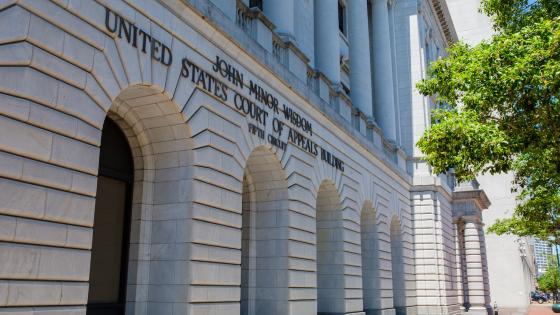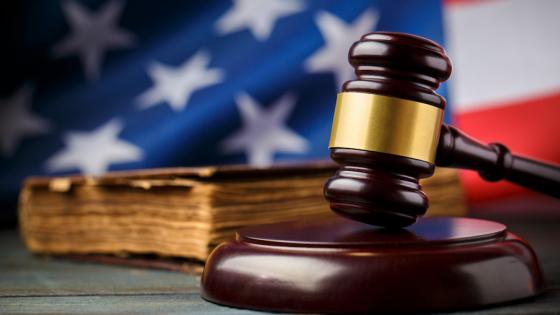It is widely believed that the identity of the US presidents appointing justices to the country’s Supreme Court can help to predict the justices’ decisions in the small number of ideologically salient issues the court considers each year. But what about the country’s federal Circuit Courts of Appeals? These courts, which are one level below the Supreme Court, consider all appeals on the rulings of federal district courts; each year they decide many thousands of cases that mostly do not seem to involve ideologically controversial cases. When, and to what extent, do the decisions of circuit court judges that are appointed by Democratic presidents (henceforth, ‘Democratic judges’) and Republican presidents (‘Republican judges’) systematically differ? This question has been the subject of a long-standing and heated debate.
The ‘traditional’ view is probably best represented by a series of articles written long ago by two former chief judges of the Circuit Court of Washington, DC (e.g. Edwards 1985, Wald 1994). These judges conceded that political affiliations are often associated with judicial decisions at the Supreme Court, but they maintained that this was largely not the case at the circuit courts. In their view, the political affiliations of circuit court judges are irrelevant to the outcomes of most circuit court cases.
By contrast, a ‘legal realist’ view on the subject has been developed, based partly on empirical research, by a number of prominent legal and political science scholars. Classic studies documented the existence of ‘party effects’ in a set of cases involving free speech, civil rights, labour relations, and criminal appeals (Songer and Davis 1990); in a set of cases reviewing decisions by the Environmental Protection Agency (Revesz 1997); and in sets of cases on ‘ideologically controversial’ issues, such as abortion, affirmative action, capital punishment, and sex discrimination (Sunstein et al. 2004). Subsequent work confirmed this pattern of party effects in various categories of cases that are ideologically controversial or salient.
Although these scholars argued that there is evidence that the political composition of circuit court panels can predict outcomes in some specific sets of cases, they mostly left unanswered the question of how broad and widespread the influence of political composition is. For example, Sunstein et al. (2004) stressed that their findings were “limited to domains where ideology would be expected to play a larger role”, and that “outside of such domains, Republican and Democratic appointees are far less likely to differ”. These authors remained agnostic on whether party effects might be present in “apparently non-ideological cases involving, for example, bankruptcy, torts, and civil procedure”, and they viewed answering this question as an important challenge for future work.
In a recent study (Alma 2023), I seek to meet this challenge. My ability to do so is facilitated by a novel dataset I have compiled, which is much larger and more comprehensive than the datasets used by earlier works on the subject. Prior empirical works have largely focused on limited sets of cases that involved ideologically salient issues and that had a published opinion. By contrast, my dataset includes about 670,000 cases from the period 1985-2020. This dataset encompasses all the varied types of cases that are considered by the circuit courts, including cases that are not ideologically salient and cases without a published opinion.
Using this dataset, I investigate whether significant party effects are present in the vast universe of circuit court cases. There are several reasons to expect Democratic and Republican judges to systematically differ in such cases. Among other things, cases that are not ideologically salient might still involve some ideological dimensions; Democratic and Republican judges could systematically differ in their attitude toward various types of parties and circumstances; and Democratic and Republican judges might differ in their approach to the judicial process, including in their views about the appropriate level of deference due to lower-court decisions. Democratic and Republican judges might even systematically differ in their personality traits and characteristics.
I find that the evidence supports the hypothesis that the political affiliations of panel judges can help to predict outcomes in a broad set of cases that together represent over 90% of circuit court decisions. The association between political affiliation and outcomes is thus far more pervasive than has been recognised by prior research. To the best of my knowledge, my paper is the first to identify and characterise such a pervasive role of party effects throughout the large universe of circuit court cases.
A substantial part of my analysis focuses on how political affiliation can help to predict outcomes in six categories of cases in which one of the parties has characteristics that could lead judges to perceive it as being in a weaker position than the other party. These six categories add up to about half a million cases. I hypothesise that Democratic judges and Republican judges systematically differ in their tendency to side with the seemingly weaker party, and I find evidence supporting this hypothesis in each of the identified six categories of cases.
One noteworthy category of cases involves civil litigation between individuals and institutions. In many such cases, though by no means all, the individual party could be perceived by judges to be the weaker party. My analysis shows that panels with more Democratic judges are more likely than Republican judges to reach a decision that favours the individual party.
Other noteworthy categories of cases involving parties of seemingly unequal power involve cases in which individuals that appear to be in a weak or vulnerable situation – such as criminal defendants, prisoners, and immigrants – litigate against governmental entities or officials. I find that, in the categories of criminal appeals, immigration appeals, and prisoner litigation, increasing the number of Democrats on a circuit court panel raises the odds of an outcome favouring the weak party.
The association between Democratic judges and ‘pro-weak’ outcomes that I identify is not only highly statistically significant but also meaningful in magnitude. To illustrate, for the six case categories as a whole, switching from an all-Republican panel to an all-Democratic panel is associated with an increase of 55% in the baseline odds of a pro-weak outcome. Thus, the odds of a Pro-weak outcome would very much depend on ‘the luck of the draw’ – that is, the political composition produced by the random assignment of judges to the panel.
Furthermore, after partitioning the universe of cases in a number of natural ways, I find that the above results are not driven by, or limited to, certain subsets of cases. The identified association is present in both cases that are ideologically salient and those that are not; in both cases with and without published opinions; and in both cases with and without an oral hearing. These patterns are present in all different circuits and during the tenure of each of the presidents serving in the examined period. Indeed, my investigation of different subsets does not identify any significant subset of cases in which having more Democratic judges on the panel does not increase the odds of a pro-weak outcome.
Going beyond the six categories of cases in which judges could view one of the parties as weaker, I also identify an association between political affiliations and outcomes in cases between parties that seem to be of equal power. In particular, I find such an association in civil litigation between two institutional private parties and civil cases between two individuals. For such cases, I hypothesise that having more Democratic judges on the panel increases the odds of the panel intervening in, rather than deferring to, the district court decision.
This 'less deference’ hypothesis is due to the possibility that Democratic and Republican judges might attach different weights to the costs and benefits of reducing deference to lower-court decisions. Relative to Republican judges, Democratic judges might attach greater weight to the ‘costs’ of leaving in place ‘mistakes’ in individual lower-court decisions, or they might attach lower weight to the resource-saving efficiency gains from deference to district court decisions, or both. Testing the 'less deference’ hypothesis, I find that the outcomes of civil litigation cases between parties that appear to be of equal power are consistent with this hypothesis.
In addition to demonstrating the pervasive role of panels’ political composition, my analysis also sheds new light on inter-panel dynamics. I show that a lone Republican judge on a panel with two Democratic judges has a stronger ‘moderating’ effect on the panel majority than does a lone Democrat on a panel with two Republican judges. I also discuss the possible reasons for, and implications of, this asymmetry between Democratic and Republican judges.
I would like to stress that, although I find systematic differences between the decisions of Democratic and Republican judges, my analysis does not take a normative view on whether one of the approaches is in some way better. For example, while I find that Democratic judges are more likely to side with the weaker party in litigation, the data do not tell us, and I take no view on, whether Democratic judges are too protective of such parties, Republican judges are insufficiently protective, or both. My contribution is merely to show how the two types of judges systematically differ in their decisions.
It is also worth stressing that my results do not imply that political affiliations fully determine outcomes or enable a prediction of panel outcomes with certainty. Circuit court decisions are undoubtedly likely to be influenced substantially by legal dimensions (such as relevant legal rules and precedents) and by the factual conclusions reached by the lower court. Therefore, these decisions mostly cannot be predicted with certainty in advance. Political affiliations are shown by my analysis not to determine outcomes, but merely to influence them. Thus, whereas knowing a panel’s political composition does not enable us to predict with certainty the panel’s decisions, knowing this composition can significantly help to assess the odds of particular outcomes.
Overall, my findings highlight the importance of the power of the United States president to appoint circuit court judges (subject to confirmation by the Senate). Each president appoints many circuit court judges, and they often continue to serve for many years after the president departs. Thus, any presidential election should be expected to have a large and enduring effect on the political composition of circuit court panels. Given my findings regarding the breadth and significance of the association between political composition and case outcomes, it is necessary to recognise that the result of any presidential election is likely to have broad and significant effects on circuit court decisions for many years to come.
To illustrate this point, consider the 2000 election between George W. Bush and Al Gore. After winning an extremely close election in 2000, Bush went on to win a second term in 2004. During his two terms in office, Bush appointed a total of 62 circuit court judges and, as of the end of 2020, 33 of them still served as active circuit court judges and 16 of them served as senior judges with a reduced load. Searching through my dataset, I find that about half of the cases decided during the period 2001-2020 had a ‘Bush-affected panel’ – that is, a panel that included one or more judges appointed by President George W. Bush.
Let us consider a hypothetical scenario in which Gore, instead of Bush, won the 2000 election and subsequently the 2004 election. Let us also assume that, in this scenario, Gore would have filled all the circuit court vacancies filled by Bush (and only those vacancies). In this hypothetical scenario, in all of the Bush-affected panels, the number of Democratic judges would have increased (and the number of Republican judges correspondingly declined) by one or more. Using the results of the regressions in my study, I estimated how a switch to the above Gore scenario would have affected circuit court decisions during the 20-year period 2001 to 2020.
Based on this exercise, I estimated that a Gore presidency would have changed the outcome of about 10,000 different cases during the period of the 20 years following the 2000 election. These changes would have included: (1) about 2,500 improved outcomes for individuals in civil litigation against institutional parties; (2) about 1,100 improved outcomes for private parties in their civil litigation against the government; (3) about 2,500 improved outcomes for criminal defendants in criminal appeals; (4) about 1,500 improved outcomes for immigrants in immigrations appeals; (5) about 1,100 improved outcomes for prisoners in prisoner litigation; and (6) about 1,200 additional reversals of lower-court decisions.
Furthermore, my dataset indicates that about 19% of the cases decided by Bush-affected panels produced an opinion that was considered to have precedential value and was therefore published. Therefore, the above estimated changes in case outcomes would likely have moved the body of circuit court precedent in directions favourable to relatively weak litigants in a broad range of legal areas.
The effects of presidential elections on the Supreme Court have long received much attention from the candidate campaigns, voters, and the media. For example, during the 2020 presidential campaign, President Trump sought to get credit from voters for nominating three conservative judges to the Supreme Court, and President Biden strongly criticised these nominations. The above discussion indicates that much attention should also be given to the effects of each presidential election on subsequent circuit court decisions. Whether a Democrat or a Republican is elected to the presidency can have a broad and long-lasting effect on the subsequent evolution of federal law doctrines and on the resolution of a massive number of individual cases.
References
Cohen, A (2023), “The Pervasive Influence of Political Composition on Circuit Court Decisions”, CEPR Discussion Paper 18409.
Edwards, H T (1985), “Public Misperceptions concerning the Politics of Judging Some Myths about the DC Circuit”, University of Colorado Law Review 56: 619.
Revesz, L R (1997), “Environmental Regulation, Ideology, and the D.C. Circuit,” Virginia Law Review 83(8): 1717-1772.
Songer, R D and S Davis (1990), “The Impact of Party and Region on Voting Decisions in the United States Courts of Appeals, 1955-1986,” The Western Political Quarterly 43(2): 317-334.
Sunstein, R C, D Schkade, and L Michelle Ellman (2004), “Ideological Voting on Federal Courts of Appeals: A Preliminary Investigation,” Virginia Law Review 90(1): 301-354.
Wald, M P (1994), “Regulation at Risk: Are Courts Part of the Solution or Most of the Problem?”, Southern California Law Review 67: 621-658.



